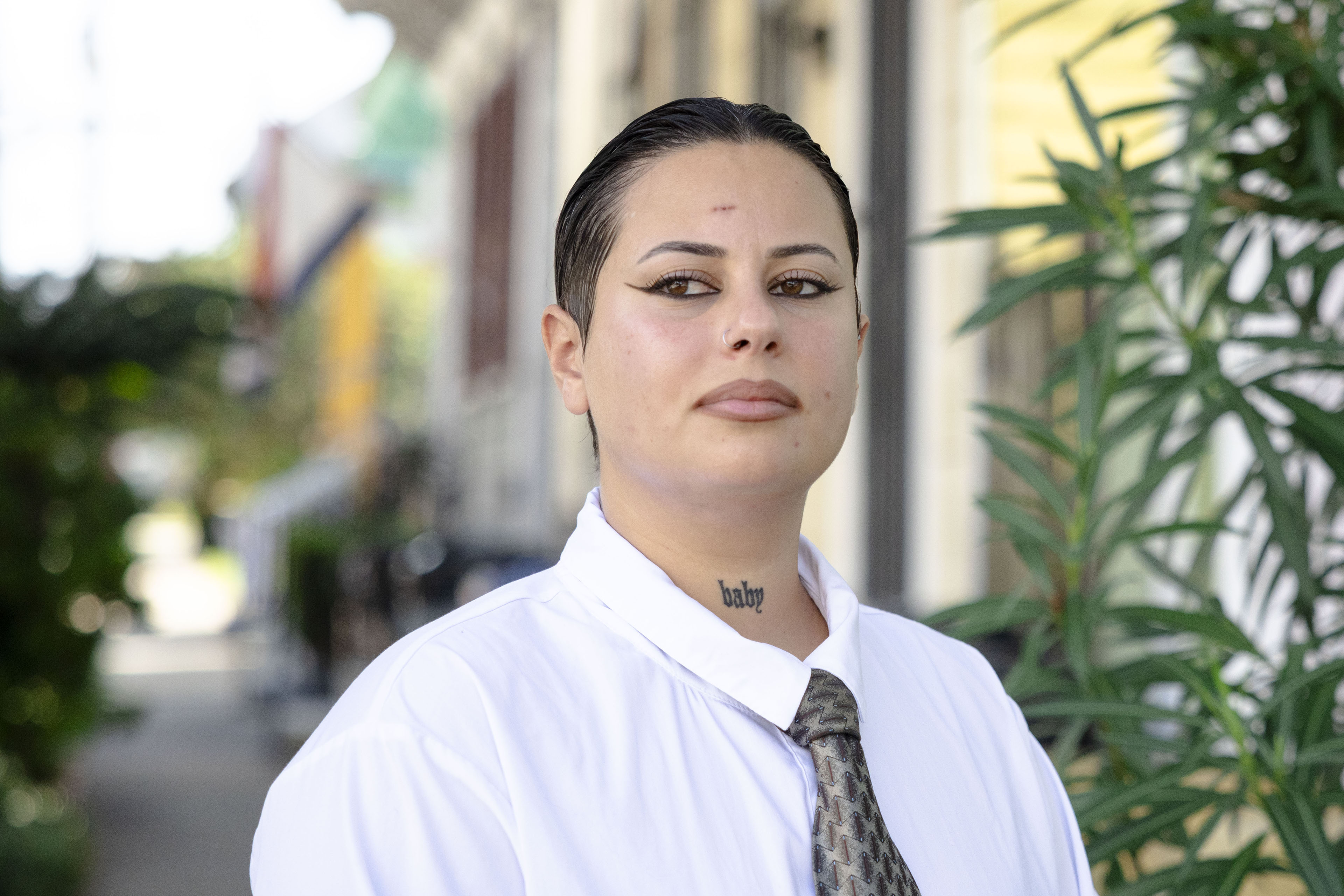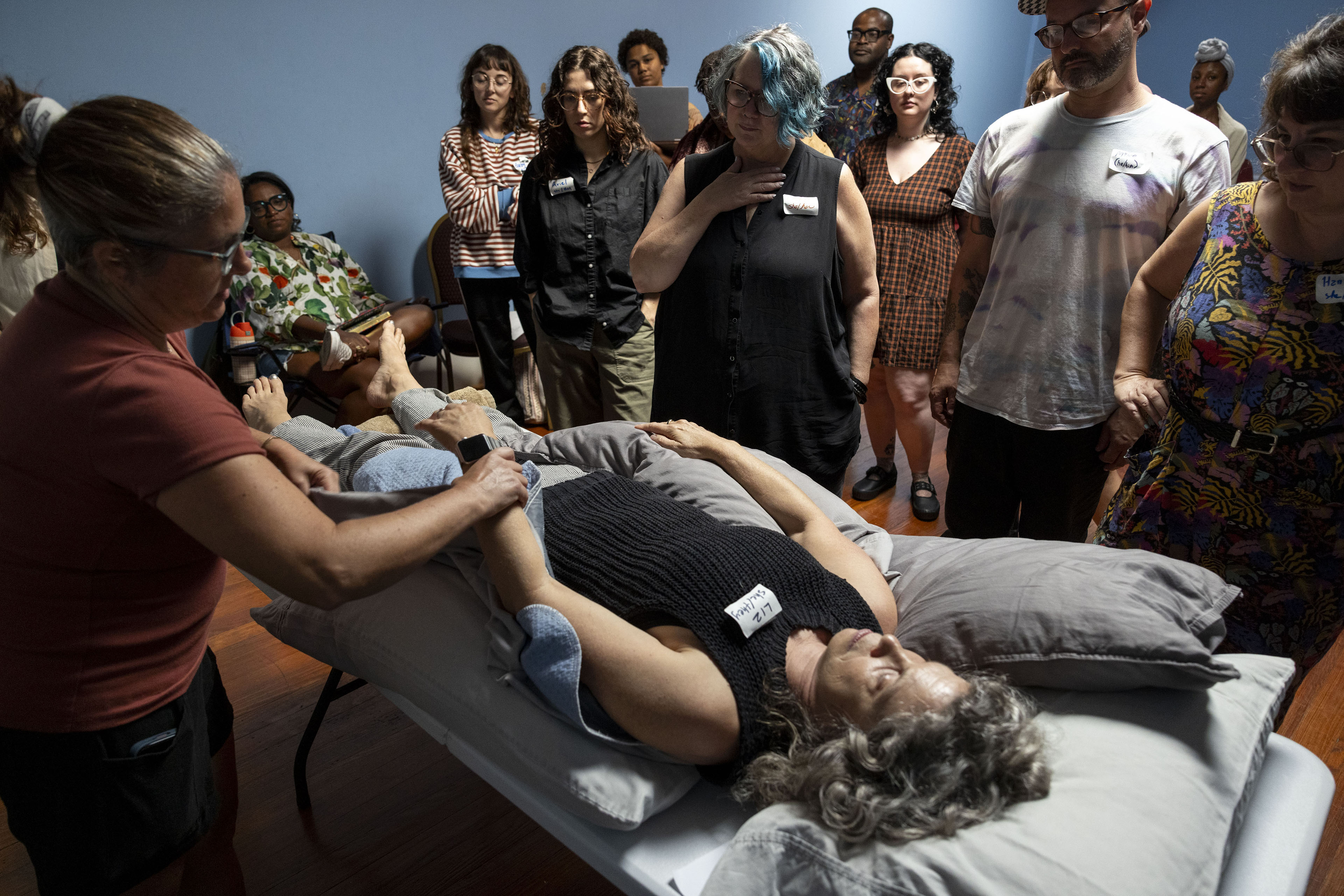Liz Dunnebacke isn’t dying, however for a latest end-of-life care workshop in New Orleans, she pretended to be.
Dunnebacke lay nonetheless atop a folding desk that was dressed as a mattress, complaining that her legs damage. Registered nurse Ana Kanellos, rolling up two small white towels, demonstrated how you can elevate her ankles to ease the ache.
“ Mom’s legs are always swollen? Raise ’em up,” Kanellos mentioned.
About 20 New Orleans residents listened intently, desirous to be taught extra about how you can take care of family members at dwelling after they’re nearing the tip of their lives. Attendee Alix Vargas mentioned she was afraid of dying. However about three years in the past, a detailed cousin’s loss of life led her to attend group writing workshops, serving to her embrace her grief and conquer her concern.
“ I’m feeling very called towards this work,” she mentioned. “It’s definitely knowledge that I wanted to obtain and expand my mind in that way. And this is also something that we’re all going to encounter in our lives.”
The workshop made her take into consideration a neighbor whose mom has dementia.
“ I was immediately thinking, ‘OK, there’s someone in my immediate orbit that is experiencing this,’” Vargas recalled. ‘“Here’s a practical way to put the mutual aid in use.’”
Demand for dwelling well being care, together with at-home hospice care, has skyrocketed for the reason that onset of the covid pandemic, as has the variety of household caregivers. An estimated 63 million folks within the U.S. — practically 1 / 4 of all American adults — offered care over the earlier yr to a different particular person with a medical situation or incapacity, often one other grownup, in response to a 2024 survey by AARP and the Nationwide Alliance for Caregiving. Prior to now 10 years, about 20 million extra folks have served as caregivers.

With practically 1 in 5 Individuals anticipated to be 65 or older by 2030, well being care consultants predict the demand for at-home caregivers will proceed to rise. On-line assets for end-of-life care are extensively obtainable, however hands-on coaching to arrange folks to change into caregivers is just not, and it may be costly. But untrained household members-turned-caregivers are taking over nursing and medical duties.
Donald Trump promised extra assist for caregivers throughout his 2024 marketing campaign, together with a pledge to create new tax credit for these caring for members of the family. He endorsed a invoice reintroduced in Congress this yr that might permit household caregivers to obtain tax credit of as much as $5,000, however the laws hasn’t moved ahead.
In the meantime, the Medicaid cuts anticipated from Republicans’ One Massive Lovely Invoice Act, which President Trump signed in July, might immediate states trying to offset their added bills to rethink collaborating in non-compulsory state Medicaid applications, such because the one which helps pay for at-home hospice care. That might threaten to make dying at dwelling much more unaffordable for low-income households, mentioned advocates and researchers.
Advocates like Osha Towers try to assist caregivers navigate the uncertainty. Towers leads LGBTQ+ engagement at Compassion & Decisions, a nationwide group that focuses on bettering end-of-life care, preparation, and training.
“It is certainly very scary, but what we know we can do right now is be able to just show up for all individuals to make sure that they know what they need to be prepared for,” Towers mentioned.
In New Orleans, a nonprofit referred to as Wake, which focuses on supporting household caregivers offering end-of-life and loss of life care, is likely one of the organizations making an attempt to assist fill the data hole. Wake placed on the free, three-day September workshop the place Dunnebacke, the group’s founder, pretended to be a dying affected person. Such workshops are geared toward getting ready attendees for what to anticipate when family members are dying and how you can take care of them, even with out expensive skilled assist. Full-time at-home care is uncommon.
“You don’t have to have any special training to do this work,” Dunnebacke mentioned. “You just need some skills and some supports to make that happen.”


In some methods, the evolution of end-of-life care within the U.S. over the previous century has come full circle. It was solely beginning within the Nineteen Sixties that individuals shifted from dying at dwelling to dying in hospitals, nursing properties, and hospice amenities.
Such establishments can present instant superior medical assist and palliative take care of sufferers, however they usually lack the human connection that dwelling care supplies, mentioned Laurie Dietrich, Wake’s applications supervisor.
Now, extra folks wish to die of their properties, amongst household, however with the assist and expertise that comes with fashionable medical amenities.
Prior to now decade, loss of life doulas — who assist the nonmedical and emotional wants of the dying and their family members — have grown in recognition to assist information folks by the dying course of, serving to to fill that hole. Douglas Simpson, government director of the Worldwide Finish of Life Doula Affiliation, mentioned his group acknowledges the dearth of assets for loss of life care, so it’s coaching doulas to be neighborhood educators. He hopes doulas may be particularly helpful in rural communities and lead conversations about dying.
“Making people more open, more comfortable about talking about death and considering their mortality,” Simpson mentioned.
Dying doula coaching varies relying on the organizer, however Simpson’s group focuses on instructing attendees concerning the dying course of, how you can keep the autonomy of the dying particular person, and the way to concentrate on how they present as much as a job and maintain themselves whereas caring for others.
Some individuals who attended Wake’s workshop had additionally attended some type of loss of life doula coaching prior to now. After Nicole Washington’s mom was killed in 2023, she thought of turning into a loss of life doula. However she thought the doula coaching, which may value $800 to $3,000, was medical and impersonal, versus Wake’s community-based method.
“I feel very energized, very uplifted,” Washington mentioned. “It’s also really nice to be in a space with people who are familiar with death and grief.”
Ochsner Well being’s Susan Nelson, who has labored as a geriatrician for 25 years, mentioned there’s a want for extra specialised applications to coach and put together caregivers, like Wake’s.
“Learning caregiving skills is probably, unfortunately, more trial by fire,” Nelson mentioned.
Compassion & Decisions is one other group making an attempt to coach caregivers. Towers mentioned the group’s coaching ranges from superior planning to performing as a well being care proxy to caring for the dying.
“We’ve gone to a place in our country where we’re so removed from end-of-life care in a way that we didn’t used to be,” Towers mentioned.
She mentioned the motion to take care of folks at dwelling and provides them neighborhood assist has roots within the AIDS epidemic, when some docs refused to care for AIDS sufferers. Pals, particularly within the lesbian neighborhood, began coordinating meals supply, visits, bedside vigils, and even contact circles, the place sufferers might obtain comforting types of contact reminiscent of hand-holding to ease ache and emotions of isolation.
“I like to look at it as a blueprint for what we can get back to doing now, which is again just prioritizing community care,” Towers mentioned.

This text was produced in collaboration with Verite Information. Verite Information reporter Christiana Botic contributed to this report.




